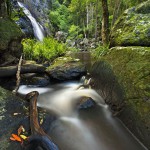Month: May 2013
Safety Tips For Seascape Photography

Some years ago, I made a serious error of judgement that could easily have brought my time on this planet to a messy end. I’d gone down to my favourite fishing spot on the tip of a rocky headland and was far more intent on catching dinner than thinking about my safety. Shortly after I arrived, a set of extra large swells rolled in and swamped the rock platform where I stood – the first only wet me up to my knees but I could see the next ones were bigger. There was no time to retreat to higher ground and the second wave picked me up and bounced me across the rocks before dumping me into deep water off the edge of the platform. Through sheer luck, the next wave didn’t pound me back into the rocks, but dragged me seaward where for the next twenty minutes I bobbed… | Read the full article
You Can’t Go Back

A few years ago I hiked the short distance down to Gheerulla Falls in Mapleton National Park for a sunrise photo session. These aren’t particularly wide or high falls – in winter they are often reduced to a trickle – but through summer the flow is usually strong and occasionally thunderous. Set amid a landscape of steep, wooded slopes, tall rainforest trees and giant boulders, the location makes a worthy subject for landscape photographers. Although I’d visited briefly before, this was the first time I’d come with the aim of exploring the photographic potential of the falls. So I spent some time scrambling around the edge of the plunge pool, framing the falls between tree trunks and using lichen-covered boulders as foreground interest. Time passes quickly when you’re caught up in the moment like this, and the pre-dawn gloom soon began to lift to give me a better view of… | Read the full article
Say No To Chromatic Aberration!

I must admit to being a Facebook junkie…but purely for professional purposes of course. The ability to see new landscape images from so many talented photographers around the world, often on the same day the image was captured, is incredibly inspiring and just an amazing way to connect with a worldwide community. But one thing that surprises me is how many good, and sometimes very good, photographers fail to correct chromatic aberration (CA) in their images. It surprises me because it is such an easy thing to correct, and because CA can turn an otherwise excellent image into an eyesore. Chromatic aberration arises when a lens fails to focus the different wavelengths of incoming light onto the same plane (the camera sensor), resulting in unsightly coloured fringes in an image. These fringes also makes images appear soft, and additional sharpening to offset the problem only results in sharper colour fringes…. | Read the full article
